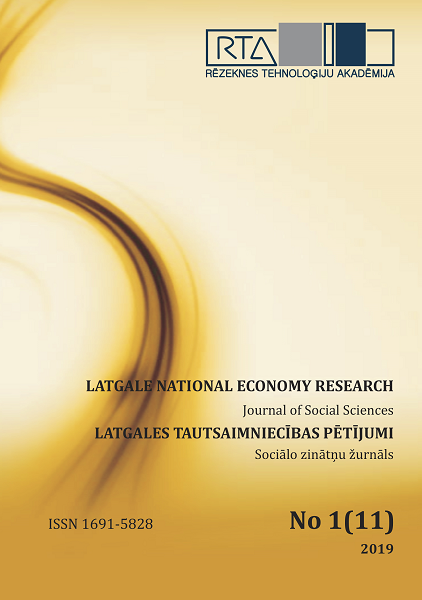SALES LABORATORY CONCEPT FOR PROBLEM SOLVING BASED LEARNING: THE EXPERIENCE OF THE BALTIC COUNTRIES
DOI:
https://doi.org/10.17770/lner2019vol1.11.4318Keywords:
entrepreneurs, problem-based learning, students, teaching staffAbstract
Very often youth faces many difficulties when trying to enter the labour market. It is because of lack of experience, insufficient vocational education, inadequacy between professional education and requirements for specialists in the job market. It is necessary that students get competencies and skills needed for the labour market and increase their employment possibilities. Rezekne Academy of Technologies implemented a project, where one of the objectives was integration of problem-based learning (PBL) into study processes. The aim of the research study is to investigate problem-based learning experiences among students and lecturers. Research methods – the monographic method, the analysis and survey methods. Problem-based learning is much more exciting for students and faculty than traditional learning, but it is also more time consuming and expertise intensive.
References
Barrows, H. S., and Tamblyn, R. (1980). Problem-Based Learning: An Approach to Medical Education, Springer, New York.
Bezdarba līmenis (2018). Centrālās statistikas pārvaldes datubāze. Retrieved from http://data1.csb.gov.lv/pxweb/lv/sociala/sociala__nodarb__bezdarbs__ikgad/?tablelist=true
Cindy E. Hmelo-Silver, C. E. (2004) Problem-Based Learning: What and How Do Students Learn? Educational Psychology Review, Vol. 16, No. 3
Cognition and Technology Group at Vanderbilt (1997). The Jasper Project: Lessons in Curriculum, Instruction, Assessment, and Professional Development, Erlbaum, Mahwah, NJ.
Collins, A., Brown, J. S., and Newman, S. E. (1989). Cognitive apprenticeship: Teaching the crafts of reading, writing, and mathematics. In Resnick, L. B. (ed.), Knowing, Learning, and Instruction: Essays in Honor of Robert Glaser, Erlbaum, Hillsdale, NJ, pp. 453-494.
Dewey, J. (1938). Experience and Education, Macmillan, New York.
Duch, B. J., Groh, S. E, & Allen, D. E. (Eds.). (2001). The power of problem-based learning. Sterling, VA: Stylus.
Hmelo, C. E., and Ferrari, M. (1997). The problem-based learning tutorial: Cultivating higher-order thinking skills. J. Educ. Gifted 20: 401-422.
Kilpatrick, W. H. (1918). The project method. Teach. Coll. Rec. 19: 319-335.
Kilpatrick, W. H. (1921). Dangers and difficulties of the project method and how to overcome them: Introductory statement: Definition of terms. Teach. Coll. Rec. 22: 282-288.
Kolodner, J. L., Hmelo, C. E., and Narayanan, N. H. (1996). Problem-based learning meets case-based reasoning. In Edelson, D. C., and Domeshek, E. A. (eds.), Proceedings of ICLS 96, AACE, Charlottesville, VA, pp. 188-195.
SalesLabs for employability competencies development/Nodarbinātības kompetenču uzlabošana pārdošanas laboratorijās (2017) Retrieved from https://www.rta.lv/citi_projekti?project_id=96
Spector, J. M., Merrill, M.D., Jeroen van Merriënboer, Driscoll, M.P. (2008) Handbook of Research on Educational Communications and Technology 3rd Edition. Lawrence Erlbaum AssociatesTaylor & Francis Group
Strods, G., Igavens, M., Tandzegolskiene, I., Shevtshenko, E. (2019) Implementing Interdisciplinarity in Career Guidance. Guidebook for career counselors, Tallinn


